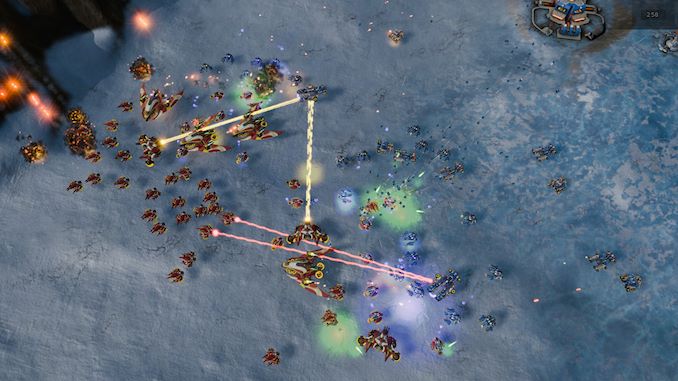Upgrading from an Intel Core i7-2600K: Testing Sandy Bridge in 2019
by Ian Cutress on May 10, 2019 10:30 AM EST- Posted in
- CPUs
- Intel
- Sandy Bridge
- Overclocking
- 7700K
- Coffee Lake
- i7-2600K
- 9700K
Gaming: Ashes Classic (DX12)
Seen as the holy child of DirectX12, Ashes of the Singularity (AoTS, or just Ashes) has been the first title to actively go explore as many of the DirectX12 features as it possibly can. Stardock, the developer behind the Nitrous engine which powers the game, has ensured that the real-time strategy title takes advantage of multiple cores and multiple graphics cards, in as many configurations as possible.
As a real-time strategy title, Ashes is all about responsiveness during both wide open shots but also concentrated battles. With DirectX12 at the helm, the ability to implement more draw calls per second allows the engine to work with substantial unit depth and effects that other RTS titles had to rely on combined draw calls to achieve, making some combined unit structures ultimately very rigid.
Stardock clearly understand the importance of an in-game benchmark, ensuring that such a tool was available and capable from day one, especially with all the additional DX12 features used and being able to characterize how they affected the title for the developer was important. The in-game benchmark performs a four minute fixed seed battle environment with a variety of shots, and outputs a vast amount of data to analyze.
For our benchmark, we run Ashes Classic: an older version of the game before the Escalation update. The reason for this is that this is easier to automate, without a splash screen, but still has a strong visual fidelity to test.
Ashes has dropdown options for MSAA, Light Quality, Object Quality, Shading Samples, Shadow Quality, Textures, and separate options for the terrain. There are several presents, from Very Low to Extreme: we run our benchmarks at the above settings, and take the frame-time output for our average and percentile numbers.
| AnandTech CPU Gaming 2019 Game List | ||||||||
| Game | Genre | Release Date | API | IGP | Low | Med | High | |
| Ashes: Classic | RTS | Mar 2016 |
DX12 | 720p Standard |
1080p Standard |
1440p Standard |
4K Standard |
|
All of our benchmark results can also be found in our benchmark engine, Bench.
| AnandTech | IGP | Low | Medium | High |
| Average FPS |  |
 |
 |
 |
| 95th Percentile |  |
 |
 |
 |
For Ashes we see performance differences between the chips all the way up to 4K, however the 7700K and 2600K overclocked perform almost the same at 4K. From 1440p and down however, the OC doesn't quite make the grade when being put against the 7700K, showing the difference between the two architectures and platforms.












213 Comments
View All Comments
Ironchef3500 - Friday, May 10, 2019 - link
Still running one of these...warreo - Friday, May 10, 2019 - link
same here, it's still running greatNetmsm - Friday, May 10, 2019 - link
No! It dose not run great, this is 9700k that runs very disappointing.flyingpants265 - Saturday, May 11, 2019 - link
Hah, I get your point. But as of this moment, 9700k is one of the best desktop CPUs out there.Netmsm - Saturday, May 11, 2019 - link
:)It'd be better to say 9700k is one of the best Intel's desktop blah, blah, blah.
jgraham11 - Monday, May 13, 2019 - link
9700k can pump out the most frames per second but it is not the best by any means, its utilization it typically more than %80. Just like a few years ago when all those quad cores were doing so great compared to AMDs more cores and more thread approach. Now those quad cores that put out all those frames are struggling to keep up in modern titles, those AMD processors are still putting out descent frame rates! Another example of AMD's fine wine technology.With that said, is the frames per second really a good metric to determine longevity of a processor?? Or should be looking at CPU utilization as well.
lmcd - Thursday, January 21, 2021 - link
This article is old but "fine wine" about AMD's old processors is pure delusion. 2600k-age AMD looks horrible. Bulldozer was always horrible, and Piledriver has looked worse with age. Even Excavator gets absolutely smoked by most old Intel CPUs. While obviously not identical and much higher power, an Intel 3960X still went even with nearly every Ryzen 1 CPU. Fine wine my ass.yankeeDDL - Sunday, May 12, 2019 - link
Actually, this is a pretty fair summary. The 9700K, 9 years later, offers about 40% advantage over the 2600 (except in gaming, where more cores don't matter, today), which is quite abysmal.Vayra - Monday, May 13, 2019 - link
More cores don't matter? What results have you been looking at for gaming? 4K ultra?yankeeDDL - Monday, May 13, 2019 - link
Obviously, I was referring at the article. "More cores" meant going from 4 of the 2600 to 8 of the 9700. And no, they don't matter, unless you see a benefit of running at 300fps instead of 250fps. At high res, when the fps start coming close to 60fps, the 2600 and the 9700k are basically equivalent.A different story would be going from 2 to 4, but this would have nothing to do with the article...
Is it clear now?